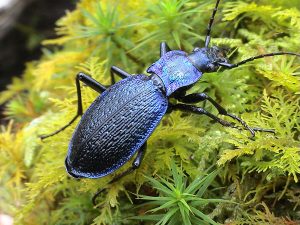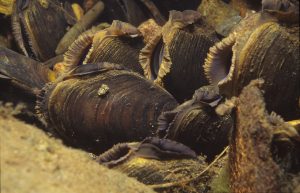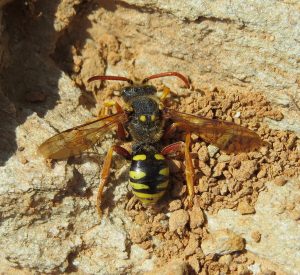Saving the small things that run the planet
Important Invertebrate Areas About IIAs Selecting and Mapping IIAs Supporting Invertebrate Conservation IIAs in Planning IIA Landscapes Single Species IIAs Using IIA Maps and Profiles FAQ IIA Data Providers IIA Document Library IIA Shapefiles
Important Invertebrate Areas (IIAs) are the best places in Great Britain for our invertebrates, which have been identified using the most up-to-date data available from over 80 national expert recording schemes. They support some of our rarest and most threatened species, vulnerable habitats and unique assemblages of invertebrates.
IIA Landscapes
Some IIAs cover large landscapes, supporting a range of habitats and are home to impressive lists of nationally rare and scarce invertebrates. Each of these IIAs is unique, with its own assemblages but also its own set of threats and challenges.
Expand the case studies below to explore some our Landscape IIAs.
South Wales Coast
The South Wales Coast IIA covers 251km squared from Neath in the west to Newport in the east and is home to 90 IIA qualifying species.
Sand dunes at Merthyr Mawr © allyhook (Flickr, CC)
More information

This coastal IIA includes a rich variety of habitats including sand dune systems, diverse grasslands, flower-rich brownfield habitats, saltmarsh and scrub among many others. This diverse landscape means it boasts populations of High Brown Fritillary (Argynnis adippe), Strandline Beetle (Eurynebria complanata), Medicinal Leech (Hirudo medicinalis), Fen Raft Spider (Dolomedes plantarius) and Blue Ground Beetle (Carabus intricatus) to name a few. All of this is within one of the most densely populated areas of Wales, with a history of heavy industry and intense agricultural activity.
Although much of the coastline benefits from national and international designations, such as the western extent of the Gwent Levels Sites of Special Scientific Interest (SSSI), Kenfig National Nature Reserve (NNR) and Merthyr-Mawr SSSI, over 80% of the entire IIA remains unprotected. This includes undesignated land at the Port Talbot steelworks and extensive land surrounding Bridgend and the Cefn Cribwr group of SSSIs. Much of this is only designated as Local Wildlife Sites so lack statutory protection, or worse, brownfield land at constant risk of being lost to development.

Dornoch Firth
The Dornoch Firth IIA in Scotland is dominated by a suite of national and international designations, including the Dornoch Firth and Loch Fleet Special Protection Area (SPA) across much of the coast.
Dornoch Firth, Scotland © Roy Lathwell (Flickr, CC)
More information

It supports a rich mosaic of saltmarsh, sand dunes, dune slacks, dune grasslands and wetlands found in the eastern coastal stretch of the Dornoch Firth and Morrich More Special Area of Conservation (SAC) and Dornoch Firth Site of Special Scientific Interest (SSSI), and the Loch Fleet SSSI on the east coast north of Embo. This complex of protected sites is home to the globally endemic and Endangered Fonseca’s Seed Fly (Botanophila fonsecai), and a nationally important assemblage that includes the Rose Pigmy Moth (Stigmella spinosissimae), Black Isle Groundling (Caryocolum blandelloides) and Brush-horned Sand Beetle (Orthocerus clavicornis).
Mound Alderwoods SAC/SSSI is at the head of Loch Fleet and supports the largest stand of Alder woodland growing around an estuary in Britain, with dense wet woodland, open fen and brackish lagoons and populations of Pearl-bordered Fritillary (Boloria euphrosyne). The lower reaches of the River Evelix SAC completes the IIA, which support the only remaining small east coast river population of the UK/European Critically Endangered Freshwater Pearl Mussel (Margaritifera margaritifera).
Despite this outstanding interest, key sites in the Dornoch Firth IIA remains under threat from coastal developments as well as from climate change.

South Devon Coast
The South Devon Coast IIA is home to some truly special species and habitats.
Prawle Point, South Devon © Hayley Herridge
More information

The network of hard and soft rock coastal cliffs, slopes, and cliff top grasslands support a nationally important assemblage of invertebrates, largely within protected coastal sites from the Bolt Head to Bolt Tail Site of Special Scientific Interest (SSSI) to the Hallsands-Beesands SSSI. These habitats support the Six-banded Nomad Bee (Nomada sexfasciata) – Britain’s rarest bee which is now only found at Prawle Point, Mediterranean Oil Beetle (Meloe mediterraneus), and the Critically Endangered Devon Red-legged Robberfly (Neomochtherus pallipes).
This diverse IIA includes the coastal habitat mosaic of Slapton Ley SSSI, estuaries and important inland grasslands and heathlands such as the East Devon Pebblebed Heaths SSSI, each with their own assemblage of invertebrates. South Devon is also home to two endemic species. The wooded river valleys are a refuge for the endemic British False-flatback Millipede (Anthogona Britannica)- which is found nowhere but South Devon, and the IIAs network of caves, aquifers and wells support the endemic British Cave Shrimp (Niphargus glenniei).
However, despite the extent of designated landscape, much of this special interest remains at risk. Cliff and coastal protections have interrupted the dynamic natural processes of the cliff landscape which coupled with the loss of flower-rich clifftop grassland is leading to suitable habitat being squeezed. Other land uses are competing for wildlife for space, including intensive agriculture, and tourist destinations such as caravan parks and golf courses. Across the IIA the landscape has lost diverse habitat mosaics that many invertebrates need.
Buglife is part of the South Devon AONB led Life on the Edge partnership project that is looking to improve stretches of this coastline within the IIA for some of its special invertebrates, including the Six-banded Nomad Bee. The project will restore wildflower-rich clifftop grasslands, better manage grassland-scrub mosaics and work with landowners to better manage wildflower-rich habitats throughout the southern section of the IIA.
